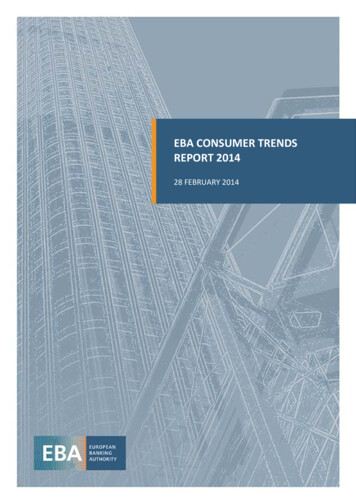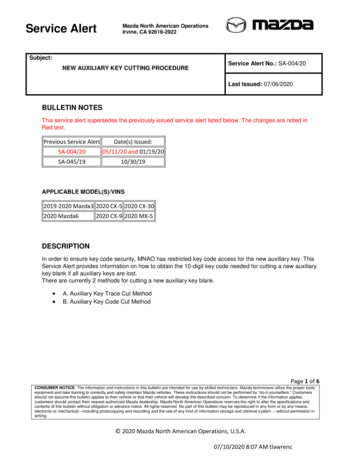
Transcription
White PaperFour key trends in the networked use of FPGAsThe use of Field-Programmable Gate Arrays (FPGAs) is growing. Their unique mix of configurable programmablelogic, memory and network connectivity makes them a serious alternative to traditional microprocessors where largeamounts of parallel processing are needed.They are widely used for video encoding, digital signal processing, neural networks, medical devices, scientificinstruments, avionics and much more. Demand is skyrocketing, not least thanks to Amazon offering its EC2 F1 virtualmachines with FPGA coprocessors. Microsoft has used FPGAs extensively within Azure. On the networking side, anincreasing number of off-the-shelf devices contain FPGAs to perform tasks uch as switching, routing, buffering, filteringand more.FPGAs have the key advantage that they are inherently reconfigurable. Bugs in their application logic can be fixed,features added or platforms reconfigured to implement different application. From the perspective of FPGA applicationdevelopers, this results in fewer design compromises as they now have the ability to adapt functionality to changingrequirements. This guide introduces four different networked applications that are seeing increasing growth in the useof FPGAs.arista.com
White PaperFPGAs enabling software-defined networkingSDN is a concept that essentially decouples the control plane of computer networks from the actual devices implementing thenetwork. SDN has been around in one form or another since the mid 1990’s however the inexorable growth of network trafficvolume, the trend towards the cloud computing model of shared, easily provisioned, mobile, abstracted services and the needfor improved network security has now made it a multi-billion dollar market that is growing rapidly. There are various standardsfor the SDN control plane with the Open Networking Foundation (ONF)’s OpenFlow probably the most significant. Otherproprietary solutions include VMware’s NSX for example. The data plane that actually processes raw network packets is traditionallyimplemented in an application specific integrated circuit (ASIC) microchip. ASICs in this context are microchips designed to switchand/or route Ethernet packets between ingress and egress ports. In the case of a traditional switch or router, these are coupled witha proprietary control plane however in an SDN device, the control plane is abstracted from the switching ASIC which may supportone or more of the SDN control plane standards.A key limitation of the SDN control plane standards is that they can only implement functionality available within the hard-codeddata plane implementation. Consequently, if someone wants to create, extend or evolve a network protocol and the data plane isnot designed to support it, the SDN network as a whole cannot implement it. Even minor changes could require re-engineering theASICs implementing the data plane - a lengthy and extremely costly process. As network protocols evolve ever more rapidly to keeppace with new technologies such as the Internet of things (IoT) or new security protocols, a data plane that is fully-reconfigurable isrequired. Two key initiatives are underway to achieve this:1.On the ASIC side, more flexible general-purpose programmable networking microchips are coming to market from the largervendors.2.On the FPGA side, Xilinx has introduced the concept of “softly” defined networks with a product called SDNet which allowsa completely mutable programmable data plane to be defined, updated, re-defined and implemented. SDNet specifies acompletely programmable data plane with an equally programmable control plane interface by leveraging the inherentflexibility of the FPGA. For example, rather than being bound by the data plane only processing packet headers, a contentaware data plane can be implemented. Rather than the standards in this programmable data plane space diverging, Xilinxhave developed a cross-compiler allowing implementers to translate P4, an open-source standard for describing data planefunctionality, into SDNet. A number of vendors have implemented off-the-shelf network devices with an FPGA data planeleveraging SDNet for those wishing a completely custom data (and optionally control) plane implementation.FPGAs in latency-sensitive automated tradingModern financial markets are run by automated algorithms which execute rules as to what should be bought and what sold. Theseautomated systems replace the function of the open outcry floor, which used to host day traders and market makers. To achieveprofitably, sophisticated proprietary trading and trade execution algorithms are used to decide what position to take at any giventime. Trading is time sensitive – wait too long, and the available prices change.take too long to respond and the system is tradingon stale data.Minimising the time between receiving information from the outside world, making a decision to trade and sending an order backto the markets has a direct bearing on the success of the trades. Some trading decisions might be made based on low-frequencyevents (e.g. the release of key information about an economy, or a company announcement), but others are made based on highfrequency events such as other trades occurring in the market and changing prices. The latter has become synonymous withautomated trading, and is called high-frequency trading (HFT).The majority of HFT trades are triggered based upon incoming information carried over an Ethernet network; often from a stock orderivatives exchange. Trades also go out over an Ethernet network to a trading venue. High-frequency trading is often a matter ofreceiving Ethernet data, processing it and deciding whether it triggers a trade. If it does, Ethernet data is pushed back out as fast aspossible.arista.com
White PaperUntil around 2010, HFT systems were usually implemented in software running on commodity servers often using network adaptersoffering the lowest possible latency. These HFT systems could turn around incoming network data and generate outgoing tradesin as little as two microseconds. The key factor limiting this turnaround time, or trading latency, was the time taken to get Ethernetpackets from the network to the server’s microprocessor running the trading algorithm and the resulting trades back out to thenetwork. FPGAs had been around for some years however the overhead in implementing an HFT trading system on an FPGA hasalways been significantly higher than doing so in software on a microprocessor. So why bother?As the HFT market matured, the drive to decrease latency intensified, given that, in most cases, doing so significantly increasedtrading profitability. Simultaneously, the markets have been driven to be more consistent and fair, progressing to tightly controlledco-located data centres. Ultimately this has improved the predictability and stability of the markets. Almost all FPGAs on the markethave Ethernet-capable transceivers connected directly to the FPGA fabric. These transceivers generally allow communicationbetween the FPGA fabric and the Ethernet network in low double-digit nanoseconds. Given the progress in trading system latencyover the last five years, the significant latency gains achievable via FPGAs over a commodity server have made building tradingsystems with the critical path entirely in the FPGA an attractive proposition – despite the increased engineering overhead inimplementing HFT trading strategies directly on FPGAs. FPGAs were initially used for components of a trading pipeline – for preprocessing a stream of data from the exchange, or for performing the final set of checks and balances on orders being sent to anexchange. For a specific group of low-complexity but latency-critical HFT trades, using networked FPGAs is one of the biggesttrends, with most HFT firms and banks employing them extensively as HFT trading platforms.FPGAs for network capture and timestampingThe volume of network traffic continues to increase year-on-year driven by such factors as booming smartphone adoption, IoT, fasterbroadband and increasing internet video. Monitoring, troubleshooting and securing network traffic therefore gets increasinglydifficult. FPGAs are a natural fit for capturing network traffic given their large number of Ethernet transceivers and customisablelogic. For example, the more powerful models from Xilinx have up to 128 25 GbE-capable transceivers. From a network captureperspective, those transceivers can receive up to 64 full-duplex Ethernet links. As completely programmable devices, FPGAs allowapplications to process network traffic arriving on each port in parallel which provides the capacity to filter, buffer, aggregate orotherwise process these huge volumes of traffic.Moverover network traffic on any given Ethernet link is often bursty, only using on average a fraction of the bandwidth over anygiven second. Using FPGAs, captured streams can be buffered and frames aggregated into a significantly smaller number of streamsto be forwarded to remote analytics or security devices. When configured for this use case, the solution is often referred to as anAggregation Tap or Packet Broker. Buffering size can vary enormously with some solutions leveraging RAM external to the FPGA andoffering tens of gigabytes of buffering.FPGAs are also capable of implementing logic for timestamping the arrival of each Ethernet packet to nanosecond (or lower)resolution. Why timestamp captured networked packets accurately? When analysing network traffic, the “when” is just as importantas the “what”. For example, comparing timestamps on the same packet at different points in the network can allow congestion to bedetected before network device buffers overflow, making remediation proactive rather than reactive. From a security perspective,knowing precisely when each network event of interest happened allows the exact causality of an incident to be reproduced.Almost all of the Ethernet capture solutions on the market are FPGA-based and generally come in one of two forms: either as apluggable board for an off-the-shelf server or as a specialised platform built around one or more FPGAs offering high port densitye.g. 48 Ethernet ports in 1 rack unit (RU) as well as integrated local and remote management capabilities.arista.com
White PaperFPGAs for networked videoThough video, streamed digitally over computer networks , has been generally available since the early-1990s, proprietary standardsabounded both for the transport protocol and the video and audio that was being transported. Before the first standard fordigital broadcast video, SD-SDI, was ratified in 1989, analogue video was the norm for the majority of the broadcast world. On theconsumer side, the first consumer camcorders offering adherence to a new Digital Video (DV) standard arrived in 1995. There werealso several proprietary versions of DV aimed mainly at professional and broadcast users. Following on the next year, in 1996, thereal-time transport protocol (RTP) standard for delivering audio and video over IP networks was ratifed providing an alternative toa number of incompatible transport and video/audio payload standards. It took until 2007 for SMPTE 2022, a harmonised standardfor the transport of digital broadcast video over IP networks to become available. Standards have also had to keep evolving asresolutions and bitrates have increased - SD, HD, 4K, 8K. Video surveillance and videoconferencing usage are growing rapidly andare bringing their own standards to the mix. As Ethernet networks become ubiquitous, developing a dedicated video cablinginfrastructure becomes less and less attractive and thus the preferred transport for digital video.Given the plethora of digital video formats and resolutions, both standardised and proprietary, working with them and interfacingbetween them is extremely difficult. Digital video formats vary, they may or may not be compressed or security encoded highdefinition multimedia interface (HDMI). Digital video transports can be cables, digital files or via digital networks yet they all need tointeroperate. Uncompressed HD bitrates today exceed 1 Gbps with 8K taking them up to 24 Gbps for a single stream. The real-time,deterministic processing required for live video switching or editing thus becomes a difficult technical problem to solve. The SDIstandards and SMPTE 2022 also allow multiple simultaneous “streams” of video, audio, timecode and ancillary data such as closedcaptioning, making processing them far from straightforward. These challenges have proved to be an extremely good fit for FPGAs.They come with the ability to interface with Ethernet networks as well as digital serial lines and provide precisely the type of digitalsignal processing (DSP) required for converting video, audio and metadata from one format to another - including digitisinganalogue video - at whatever rate is required, or switching between synchronised streams. It is particularly difficult to interfacebroadcast and consumer products where the adherence to the consumer standard may be incomplete or imperfect. FGPA vendorsoffer off-the-shelf FPGA software modules that know how to “speak” the most popular broadcast standards such as SMPTE 292M(HD-SDI) and SMPTE 2022-5,6 (video over IP) and consumer standards such as HDMI, making designing custom digital videoprocessing solutions much easier. Their main competition is ASIC-based solutions. Though ASICs also excel in this sort of processing,their programmed inflexibility is at odds with the need to support the hundreds of implementations still being used and theconstant evolution of both existing proprietary and ratified standards. The programmable nature of FPGAs, on the other hand, isan extremely good fit to support this evolution of standards. FPGAs can be found in consumer video devices such as digital videocameras, DVD and Blu-ray players and LCD televisions. They can also be found in studio cameras and most professional videoprocessing equipment.arista.com
White PaperConclusionFPGAs are playing a steadily growing role in a number of networked application areas. In this article, we have looked at their abilityto offer a fully-programmable data plane for SDN, their use in offering financial trading firms the lowest possible latency, theirpreeminence in the booming network capture and timestamping market, providing the capability to offer high-density networkcapture and aggregation and finally their ubiquity in both the professional and consumer video market.For networked applications requiring extremely low-latency, deterministic processing without the commitment of locking theapplication into hardware, FPGAs are often the best fit.Santa Clara—Corporate Headquarters5453 Great America Parkway,Santa Clara, CA 95054Phone: 1-408-547-5500Fax: 1-408-538-8920Email: info@arista.comIreland—International Headquarters3130 Atlantic AvenueWestpark Business CampusShannon, Co. ClareIrelandIndia—R&D OfficeGlobal Tech Park, Tower A & B, 11th FloorMarathahalli Outer Ring RoadDevarabeesanahalli Village, Varthur HobliBangalore, India 560103Vancouver—R&D Office9200 Glenlyon Pkwy, Unit 300Burnaby, British ColumbiaCanada V5J 5J8Singapore—APAC Administrative Office9 Temasek Boulevard#29-01, Suntec Tower TwoSingapore 038989San Francisco—R&D and Sales Office 1390Market Street, Suite 800San Francisco, CA 94102Nashua—R&D Office10 Tara BoulevardNashua, NH 03062Copyright 2018 Arista Networks, Inc. All rights reserved. CloudVision, and EOS are registered trademarks and Arista Networksis a trademark of Arista Networks, Inc. All other company names are trademarks of their respective holders. Information in thisdocument is subject to change without notice. Certain features may not yet be available. Arista Networks, Inc. assumes noresponsibility for any errors that may appear in this document. Dec. 20, 2018arista.com
increasing number of off-the-shelf devices contain FPGAs to perform tasks uch as switching, routing, buffering, filtering and more. FPGAs have the key advantage that they are inherently reconfigurable. Bugs in their application logic can be fixed, features added or platforms reconfigured to implement different application.











